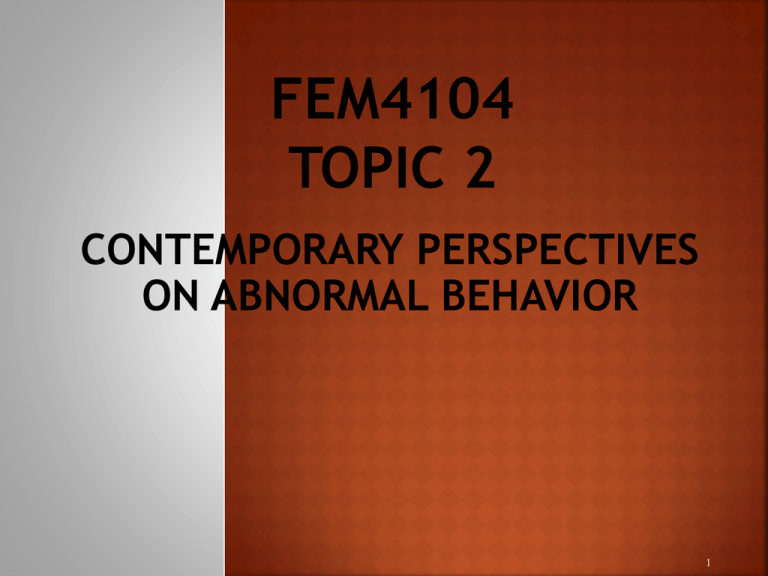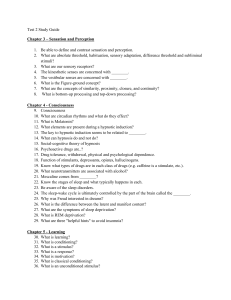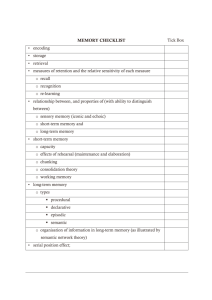PSYCHOPATHOLOGY OF CHILDREN AND FAMILY
advertisement

CONTEMPORARY PERSPECTIVES ON ABNORMAL BEHAVIOR 1 BIOLOGICAL PERSPECTIVES PSYCHODYNAMIC PERSPECTIVES BEHAVIORAL PERSPECTIVES HUMANISTIC-EXISTENTIAL PERSPECTIVES 2 The nerve system - Neuron - Soma @ Cell body - Dendrites - Axon - Axon Terminal - Neurotransmitters - Synapse 3 4 5 Excesses or deficiencies of neurotransmitters have been linked to various kind of mental health problem Excesses and deficiencies of neurotransmitter norepinephrine have been connected with mood disorders Neurotransmitter acetylcholine related to Alzheimer's disease Serotonin linked to various psychological disorders including anxiety disorders, mood disorders and eating disorders 6 The Structure of the Mind Conscious mind Preconscious mind Unconscious mind 7 Id: Operates according to the pleasure principle Primitive and unconscious, hidden from view Contains basic drives Ego: Operates according to the reality principle Mediates the conflict between id and superego Superego: Consists of moral ideals and conscience 8 Oral Stage (birth to 18 months) First stage of Freud’s theory of personality development, in which the infant’s erotic feelings center on the mouth, lips and tongue. 9 Anal Stage (roughly 18 months to 3 ½ years) Second stage of Freud’s theory of personality development in which a child’s erotic feelings center on the anus and on elimination 10 Phallic Stage (after age 3) Third stage of Freud’s theory of personality development in which erotic feelings center on the genitals Oedipus complex and Electra complex – a child’s sexual attachment to the parent of the opposite sex and jealousy toward the parent of the same sex; generally occurs in the phallic stage 11 Latency Period (5 to 12 @ 13 years old) The child appears to have no interest in the other sex; occurs after the phallic stage Genital Stage Final stage of normal adult sexual development which is normally marked by mature sexuality 12 Normal as well abnormal people are driven by the irrational drives of the id Normality - balance of energy among the psychic structures of id, ego and superego. Abnormality – the balance of energy is lopsided 13 Classical Conditioning - Ivan Pavlov (1849 – 1936) - A response naturally elicited by one stimulus comes to be elicited by a different, formerly neural stimulus Unconditioned stimulus (US) - stimulus that invariably causes an organism to response in specific way 14 Unconditioned response (UR) - A response that takes place in an organism whenever an unconditioned stimulus occur Conditioned stimulus (CS) - An originally neural stimulus that is paired with an unconditioned stimulus and eventually produces the desired response in an organism when presented alone Conditioned response (CR) - After conditioning, the response an organism produces when only a conditioned stimulus is presented 15 Before Conditioning Bell No Response US (food) UR (Salivation During Conditioning CS (Bell) –Followed by- US (Food) UR (Salivation) After Conditioning CS (Bell) CR (Salivation) 16 Operant Conditioning involves the acquisition of behaviors called operant behaviors that are emitted by the organism and that operate upon or manipulate the environment to produce certain effects. Operant behaviors Behavior designed to operate on the environment in a way that will gain something desired or avoid something unpleasant 17 Reinforcer - A stimulus that follows a behavior and increases the likelihood that the behavior will be repeated Punisher - A stimulus that follows a behavior and decreases the likelihood that the behavior will be repeated Positive Reinforcer - Any event whose presence increases the likelihood that ongoing behavior will recur Negative Reinforcer - Any event whose reduction or termination increases the likelihood that ongoing behavior will recur 18 Social Cognitive Theory emphasizes the ability to learn by observing a model or receiving instructions without firsthand experience by learner Example – phobias may be learned vicariously by observing the fearful reactions of others in real life 19 Carl Roger, Abraham Maslow Self Actualization - to strive to become all they are capable of being To understand abnormal behavior in the humanistic view, we need to understand the roadblocks that people encounter in striving for self actualization and authenticity 20 Information processing approach storage, retrieval, manipulation, and output - psychological disorders – disturbance of these processes 21 Low socioeconomic status and underemployment Prejudice and Discrimination Social Change and Uncertainty Urban Stressors 22 The biological perspective adopts a physiological level of analysis. It examines the role that biochemical processes such as imbalances in brain chemistry may play in the development of psychological disorders The behavioral perspective adopts a behavioral level of analysis. It focuses on how our behavior is shaped by learning experiences. 23 The humanistic existential perspective adopts a phenomenological vantage point. It explores people’s subjective experiences The cognitive perspective focuses on the role of dysfunctional thinking patterns in psychological disorders such as irrational belief The psychodynamic perspective probes the unconscious motives and conflicts that believed to underlie psychological disorders The socio-cultural perspective focuses psychological disorders in the context of the larger society. 24






